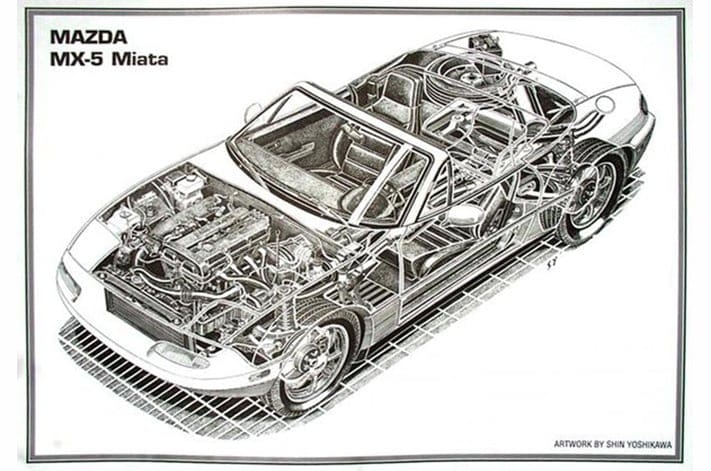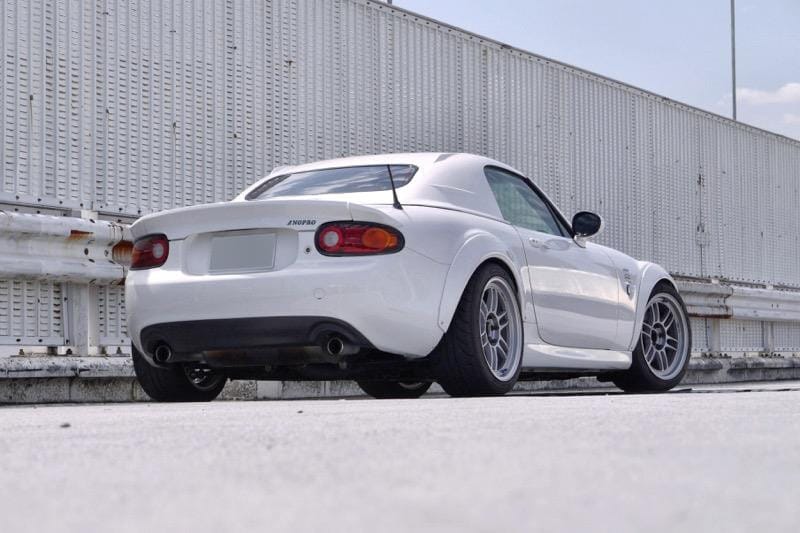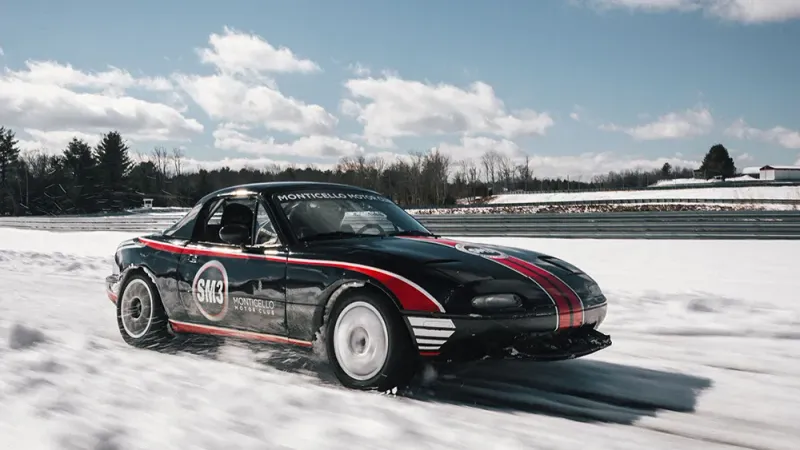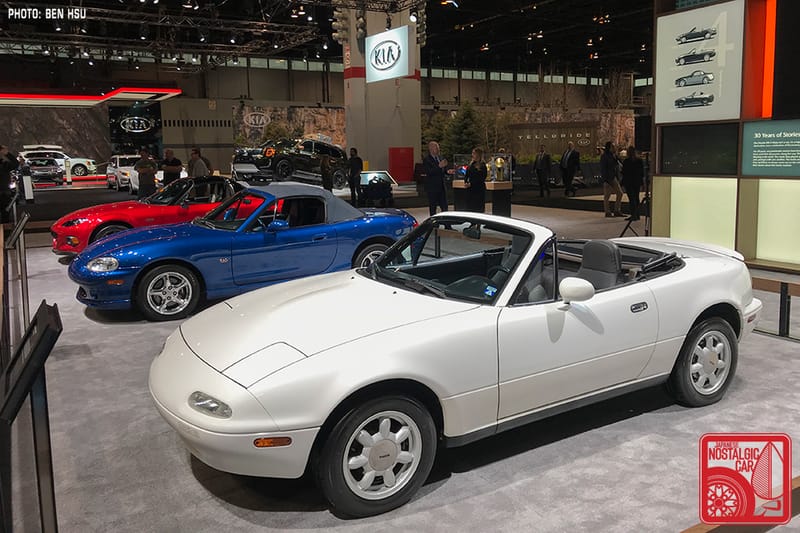How the Miata’s Design Has Influenced Other Cars
From its debut, the MX-5 delivered lightweight balance, a front-mid engine layout, and double-wishbone suspension that kept grip consistent through corners. Add a cockpit built for feel over flash, and you get the perfect formula for driver confidence.

From day one, the MX-5 mixed low mass, a front-mid engine for superb fore-aft balance, and double-wishbone geometry that kept the tire working through roll. That lightweight-first approach, plus a cockpit tuned for feel, not spec-sheet numbers, made it a go-to driver’s car and the backbone of North American club racing.
Light, Balanced, Momentum-Car Dynamics
The Miata kept weight down, chased near-50:50 balance, and prioritized steering and shifter feel over headline power. Early cars ran double wishbones front and rear, so alignment behavior stayed predictable and confidence-building at the limit. You didn’t muscle it fast; you learned to carry speed and make the tires work.

You see that same mindset in the Honda S2000 (AP1/AP2), which was engineered around a front-mid layout, low yaw inertia, and a target 50:50 distribution with double wishbones at both ends. The Toyota 86 and Subaru BRZ followed a similar brief: low weight, very low center of gravity, and balance first, power second. Reviewers constantly framed the 86/BRZ’s mission alongside the MX-5 because the priorities were identical.
On track, that matters because a light, forgiving chassis teaches speed without power and keeps consumables cheap. It’s why MX-5s and 86/BRZs trade trophies in SCCA autocross and time-trial paddocks where precision and momentum beat brute force.

Factory-Friendly Spec Racing
Mazda proved you can build a big, sustainable ladder around an affordable spec car. Global MX-5 Cup (now Whelen MX-5 Cup) takes a road car, applies a tightly controlled parts list and sealed powertrain, and ties it to real scholarships that move drivers up the IMSA ladder. At the same time, Spec Miata ballooned into the biggest class in U.S. club racing, showing how parity and parts control can keep costs sane.

That template spread. The Toyota GR Cup (GR86 one-make) converts GR86 shells at a central facility to a controlled spec and runs them as a national single-make series under SRO. Spec MX-5 (NC) then created a bridge between club and pro MX-5 racing, using a spec parts list that fit multiple sanctioning bodies. The takeaway for other brands was clear: build around a proven, inexpensive base and the grids will come.
Spec parity plus massive entries create repeatable economics. MX-5 racing demonstrated the business case so convincingly that it lowered the risk for other OEMs to green-light their own one-make cups.

Platform-Sharing
The ND Miata’s light, stiff, human-scale platform was so right that another brand used it wholesale. The Fiat/Abarth 124 Spider rides on the ND’s bones and was even built alongside it in Hiroshima. Abarth 124 Rally went a step further and turned the car into a factory R-GT contender, winning the cup and launching a one-make 124 Rally Trophy. That’s Miata DNA taking stage wins on tarmac rallies, not just circuits.
This matters because it proved a small, balanced roadster platform could pivot from road racing to rallying without big mass penalties. Suddenly, “Miata-style” engineering made sense across disciplines.
The Donor Car That Launched 1,000 Kit Racers
Miatas bundle their engine, transmission, diff, and subframes into a modular package tied together by a rigid Power Plant Frame. That makes the running gear comically easy to transplant. Entire cottage industries sprang up around stripping Miatas and bolting their guts into ultralight spaceframes. The MEV Exocet is the poster child, and cars like the Bauer Catfish follow the same “Miata heart, tube-frame body” recipe to push power-to-weight to silly levels.

For grassroots motorsports, that meant track-day specials and club racers could get near-prototype agility using junkyard-priced Miata bits. “Miata underpinnings” stopped being a punchline and became a performance building block.
The Manual-Feel
The Miata set the standard for short-throw, rifle-bolt shift quality and talkative steering. For decades, road tests of sporty manuals have used the MX-5 as the yardstick, if a shifter is crisp and positive, it’s “Miata-like.” That benchmark mentality bleeds into how engineers set their targets for everything from hot hatches to low-power RWD coupes.
On track, precise, consistent controls reduce driver workload. In spec series and endurance stints, where repeatability wins, that matters more than an extra ten horsepower.
Reshaping the Club Scene
Miatas filled paddocks. On any given weekend in the U.S., more Mazdas are road-raced than any other brand, and Spec Miata has repeatedly delivered record Runoffs fields. That participation density forced organizers to evolve tech, classing, and officiating around huge single-model grids, effectively shaping how amateur road racing operates.
Competitors noticed. Pontiac Solstice and Saturn Sky arrived explicitly to take on the Miata in roadster racing and showroom wars. And when organizers already have a thriving place for lightweight, analog cars to compete, it’s much easier for OEMs to justify programs like the 86/BRZ. Healthy grids beget more healthy grids.

The Honda S2000 and Toyota GR86/Subaru BRZ picked up the low-mass, balanced, momentum-driving playbook; Toyota GR Cup borrowed the sealed, centrally built spec-series format; the ND’s platform sharing led directly to the Abarth 124 Rally; kit cars like the MEV Exocet and Bauer Catfish turned Miata running gear into ultralight weapons; “Miata-like” control feel became the manual benchmark; and Pontiac Solstice/Saturn Sky arrived as straight-up Miata fighters.
Strip the badges off and the Miata’s influence looks less like copycats and more like a set of rules the industry rediscovered: keep it light, keep it honest, make it easy to race, and support the ladder. That formula birthed rival roadsters, seeded one-make series across brands, and even sent Miata DNA into rally stages via the Abarth 124. Three decades in, the car that taught America momentum driving is still writing the curriculum, and everyone else is borrowing the notes.




